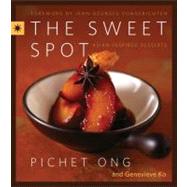
The New copy of this book will include any supplemental materials advertised. Please check the title of the book to determine if it should include any access cards, study guides, lab manuals, CDs, etc.
The Used, Rental and eBook copies of this book are not guaranteed to include any supplemental materials. Typically, only the book itself is included. This is true even if the title states it includes any access cards, study guides, lab manuals, CDs, etc.
Asian cakes are often sticky treats that taste more like candy than pastry. Glutinous rice flour lends a rich flavor and a distinctive chewy texture not found anywhere else. I love this particular version of sticky rice cake because of the fragrant pandan, which adds a fresh, floral note and vibrant green color to the cake. The result looks almost like layered Jell-O treats, but the taste is far more sophisticated.
chef's tip: Pandan leaves, also known as screwpine or bai touy, can be found frozen in Asian markets. Fresh pandan leaves, available only in Asia, impart a brilliant grass green color to desserts. To achieve the same color, you can use pandan extract, also available in Asian markets. Without the extract, the cake will be a calming shade of jade.
Ingredients:
2 teaspoons canola, vegetable, or other neutral oil for greasing the panInstructions:
1. Prepare a steamer by filling a large round casserole with water to a depth of 3 inches; the casserole should be at least 11 inches in diameter and have a tightly fitting lid. Put a steamer rack or enough crumpled heavy-duty aluminum foil to support the cake pan on the bottom; the rack or foil should be just above the waterline. Set over medium heat and bring to a steady simmer. Grease a 9-inch round cake pan with the oil and set aside.
2. Put the pandan leaves in a blender with ¼ cup of the coconut milk and 1⁄3 cup water. Blend until the pandan leaves are finely chopped. Strain the mixture through a fine-mesh sieve lined with cheesecloth, pressing on the pandan leaves to extract as much liquid as possible. Discard the leaves and set the liquid aside.
3. In a medium bowl, combine the remaining 2¼ cups coconut milk with the sugar and stir until the sugar dissolves; set aside.
4. Mix the three flours, the cornstarch, and the salt together in a large mixing bowl. Add the coconut milk mixture and stir until well blended. Pour half the batter (about 2 cups) into another mixing bowl. Add the pandan liquid and the extract, if using, to one of the bowls and mix well.
5. Pour 1 cup of the green batter into the cake pan, tilting the pan to form an even layer. Carefully set the cake pan on the steamer rack, making sure that the pan sits as evenly as possible. Wrap a thin kitchen towel around the lid, cover the pot tightly, and steam until the cake layer is firm and set, about 4 minutes.
6. Carefully pour 1 cup of the white cake batter on top of the green batter. Pour the batter in from the side so that it will spread into an even layer naturally. Steam, covered, until the white layer is set, about 10 minutes. Repeat with the remaining batter, alternating colors.
7. When the final layer is set, turn off the heat, uncover the pot, and let the cake cool in the casserole until it is cool enough to touch.
8. Remove the cake pan from the casserole, run a knife around the edge, and cut the cake into little squares. (You can eat the trimmings yourself.) It is best served the same day, as it hardens over time.
This classic dim sum item actually originated in Portugal, where it's called pasties de nata, roughly translated as "pastries of cream." The Portuguese version is a firm egg custard in a hard shell. The Chinese version, found in just about every Chinese bakery and dim sum restaurant, is baked a little less so that the pastry and custard remain soft. My version combines the two with crisp pastry and a supple custard. I also add sweet-tart passion fruit seeds for a more complex flavor and texture.
Ingredients:
Nonstick cooking sprayInstructions:
1. Spray three mini-muffin tins with nonstick spray. Press a puff pastry round into each cup, using your fingers to press the dough flat on the bottom and up the sides of the mold. Chill in the freezer, uncovered, while you preheat the oven.
2. Preheat the oven to 425°F.
3. Bake the tartlet shells until golden brown and dry to the touch, about 10 minutes. Remove from the oven and cool completely in the pans. Turn the heat down to 325°F.
4. Put the eggs, milk, and sugar in a mixing bowl and whisk until the sugar dissolves and the mixture is smooth. Stir in the passion fruit seeds, pulp, and juice.
5. Divide the passion fruit mixture among the cooled tart shells. Bake just until the custard is set, about 10 minutes; it should still jiggle a little in the center. Remove from the oven and cool slightly, then remove from the muffin tins and serve.
Key Lime Dahn Taht: Substitute ½ cup (4 ounces/113 grams) fresh key lime juice for the passion fruit seeds, pulp, and juice. (Or use 1⁄3 cup regular lime juice.)
The Sweet Spot
Excerpted from The Sweet Spot: Asian-Inspired Desserts by Pichet Ong, Genevieve Ko
All rights reserved by the original copyright owners. Excerpts are provided for display purposes only and may not be reproduced, reprinted or distributed without the written permission of the publisher.